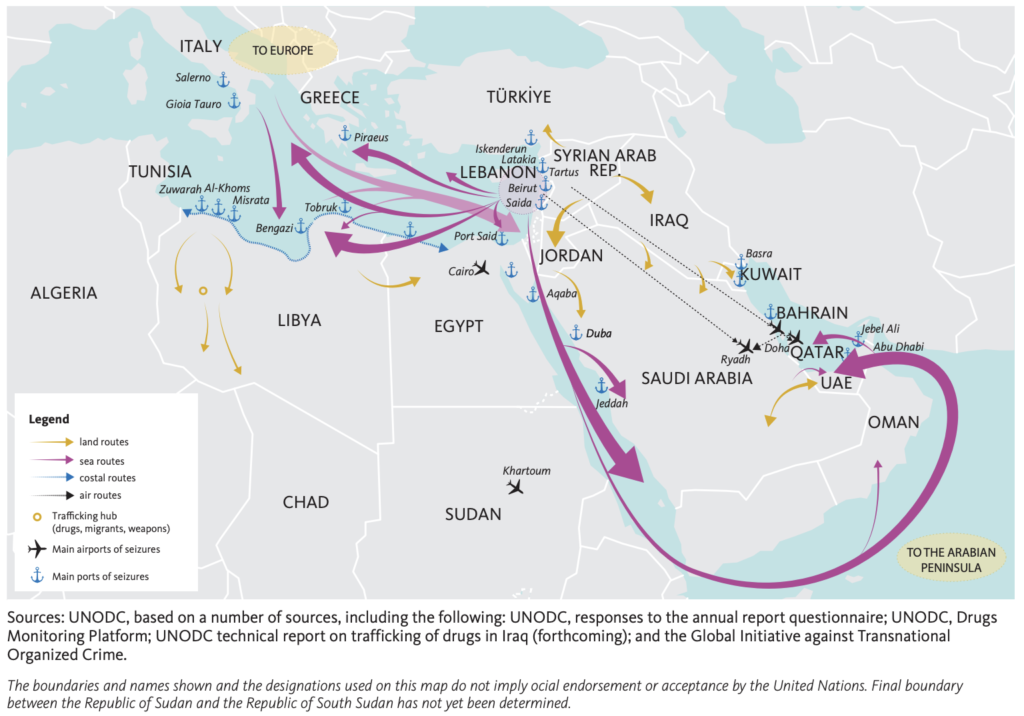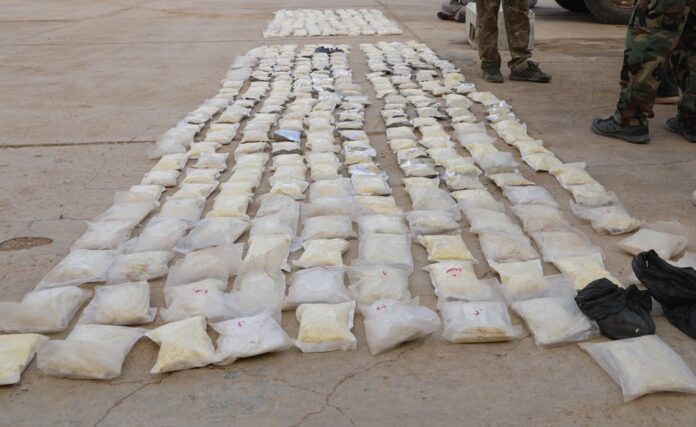Ongoing civil war has made Syria not only a safe haven for jihadist terrorism but a narco-state. Syria is now a source country for captagon production that targets and poisons the youth in the Gulf States, Northern Africa, and European Union (EU) countries. Arab states, dramatically affected by ongoing captagon trade in the region, have prioritized taking adequate measures to counter it. They have intensified military operations targeting drug smugglers in the Middle East. For example, the Jordanian authorities mounted airstrikes on drug-linked targets and killed a well-known Syrian smuggler in a military operation on May 8, 2023. Additionally, the Arab states have sought cooperation with the Syrian authorities and attempted to normalize political and diplomatic ties with the Assad government. Therefore, the Arab League invited Bashar al-Assad to its 2023 summit in Jeddah after more than a decade of isolation.
Synthetic Drugs and Captagon
Drugs are classified into two main categories: (a) plant-based drugs, primarily heroin produced from opium and cocaine produced from coca plants, and (b) lab-based drugs, chemicals processed in laboratories. According to global estimates of drug users in 2022, 209 million people used cannabis, followed by 61 million using heroin and 21 million using cocaine. The number of drug users in the synthetics category accounted for amphetamines (34 million) and ecstasy (20 million).
Synthetics, also known as stimulants, have the effects of hallucinogens or narcotics but a slightly altered chemical structure. Some of its examples are synthetic cathinones, which are human-made stimulants – more commonly known as “bath salts” – in the new psychoactive substances category. These cathinones are produced from the Khat plant grown in eastern Africa and southern Arabia. Its human-made versions can be much stronger than the natural product. Another example is synthetic cannabinoids, also known as synthetic marijuana.
Amphetamine-type stimulants dominate synthetic drug manufacturing. Amphetamines are psychostimulant drugs that speed up messages between the brain and body. Many detected clandestine synthetic drug laboratories produce amphetamine-type stimulants, primarily manufacturing the amphetamine group substances methamphetamine, amphetamine, methcathinone, and ecstasy-group substances.
Captagon is a highly addictive amphetamine that stimulates the central nervous system and keeps its users awake. It was the brand name of psychoactive medicine produced in the 1960s and was mainly prescribed as a treatment for attention deficit disorder and narcolepsy. By the 1980s, the U.S. government declared it a controlled substance with no accepted medical use. In 1986, fenetylline was included in Schedule II of the United Nations Convention on Psychotropic Substances in 1971, and most countries discontinued using Captagon.
Source and Target Countries
New counterfeit tablets labeled Captagon were produced in the 1990s and early 2000s in Bulgaria, and Turkish and Bulgarian criminal networks took the leading role in smuggling captagon pills to the Arabian Peninsula. The changes in supply and demand of captagon as well as regional politics moved its production to Syria when a brutal government crackdown on anti-Assad protesters descended the country into a civil war in 2011. In addition, demand for captagon grew when the Islamic State in Iraq and Syria (ISIS) terrorist organization expanded its influence and began to control territory. ISIS allowed its militants to use captagon because it gave heightened energy and focus.
The Assad regime’s brutality against its own people and use of weapons of mass destruction resulted in heavy sanctions on the Assad regime that plunged it into an economic crisis. According to the United Kingdom government, 80 percent of the world’s captagon is produced in Syria, and it is a financial lifeline for al-Assad’s regime, worth approximately three times the combined trade of the Mexican cartels. The regime generates U.S. $5.7 billion in revenue from drug shipments. Today drug trafficking is the country’s most important foreign currency source.
Gulf states are the primary destination countries for captagon traffickers. Captagon is a popular party drug in Saudi Arabia. In 2015, the Saudi authorities stated that the majority of the addicts were 12-22 years old, and 40 percent of this age group were captagon addicts who used these pills for academic and recreational means. Students use it to prepare for exams, but for the graduates it is to cope with the stress of being unemployed. In 2021, nearly 29 percent of Saudi youth were under the influence of captagon use. Saudi Arabia has the most captagon users, but other Gulf states increasingly record captagon use in their countries.
Actors and Routes of the Captagon Trade
Various actors have been involved in captagon trafficking. The first group is the members of the Syrian regime. The cousins and relatives of Bashar al-Assad are actively engaged in the captagon trade. One of the recent U.S. sanctions on Damascus has accused Bashar al Assad’s brother, Maher al-Assad, of facilitating the production and trafficking of captagon. The first group has immunity and enjoys endemic corruption; therefore, law enforcement and military turn a blind eye to the involvement of this group.
The second group is Iranian-backed militia groups and Hezbollah. Iran has been a vital member of the Assad bloc since the launch of the civil war. Regardless of the regime’s violence targeting and forcing the displacement of its own people, Iran has aimed to maintain Bashar al-Assad’s position in the government. Moreover, Iran has supported Shia militia groups transferred from Afghanistan and Pakistan and trained by IRGC. These militia groups were involved in terrorist attacks in Syria in 2021. Moreover, in the regions where these militia groups operate are accomplices of captagon trafficking. Similarly, Hezbollah also participated in the civil war in Syria and predominantly operated in the borderlands between Syria and Lebanon. This borderland region hosted 15 large-scale production centers on the Syrian side and 20 small-scale factories on the Lebanon side in 2022. The increasing number of captagon laboratories in this region has been the stronger indicator of Hezbollah’s dominance in the captagon trade.
The third group comprises local smugglers already part of regional and global trafficking networks. Resourceful and opportunistic, these groups have been involved in human smuggling, oil smuggling, cigarette smuggling, and antiquities trafficking in the country. Recently, these groups have taken advantage of the convergence of drug networks and have been involved in cocaine and synthetic trafficking.
The captagon trade actors use various routes to ship captagon to the destination countries in the Gulf, Northern Africa, and Europe, as seen below.

The southern routes carry captagon to Saudi Arabia, Oman, UAE, Bahrain, and Qatar, using alternative routes that pass through Iraq, Lebanon, or Jordan. For example, Jordan’s army killed 30 smugglers who attempted to ship 16 million pills from Syria in February 2022. In another seizure in March 2023, Jordanian authorities destroyed 12.8 million captagon pills smuggled from Syria. Lebanon was another country with captagon busts in 2023. For example, Lebanon’s security forces seized an estimated 10 million captagon pills in April 2023. In addition, Iraqi authorities seized three million Captagon pills hidden in apple crates on the Syrian border in March 2023. The destination countries also seized massive amounts of pills. For example, the Saudi authorities seized five million pills in one of its latest busts in May 2023.
The western route carries Syrian captagon to Egypt and northern African countries. Egyptian authorities seized $39 million worth of captagon pills transferred from Lebanon in January 2021. In February 2023, the Italian authorities thwarted an attempt to smuggle 14 tons of captagon destined for Libya and Saudi Arabia. Morocco is another transit country on the western route to transfer captagon to the West African countries and EU. In November 2022, Moroccan authorities seized over two million Captagon pills concealed inside a container and headed from Lebanon to West Africa.
The northern route passes through Turkiye, which has received severe criticism due to its porous borders and turning a blind eye to the illegal border crossings of jihadist militants. Over the years, Turkish and Syrian smugglers have collaborated to smuggle human beings, oil, cigarettes, and drugs. Antiquities traffickers also used Turkish land to transfer Syrian historical artifacts to destination countries in Western Europe. The recent regime change and deepening authoritarianism turned the country into a kleptocratic regime, generating favorable ground for drug traffickers. Turkey today is an active hub for cocaine transferred from Latin America and destined to Russia, EU countries, and primarily drug markets in the Gulf States. Similarly, captagon traffickers have increasingly used Turkish land. For example, the police seized 193,000 captagon pills in Hatay province bordering Syria in January 2023. Turkish customs officials seized 2 tons of cocaine in Istanbul port in August 2022. In another seizure in Istanbul in April 2022, the police seized 900,000 captagon pills from three traffickers: two Syrian and one Lebanese.
Does normalizing relations with Syria impact the captagon trade?
The United States, United Kingdom, and European Union have all imposed new sanctions on Syria due to the regime’s strong linkages with the Captagon trade. The U.S. government is against normalizing ties with the Assad government and favors sanctions that remain in full effect.
The growing captagon threat is one of the factors that has pushed Arab states to re-establish relationships with the Syrian government. Therefore, Bashar al-Assad received a welcoming invitation to join the Arab League’s summit in Jeddah on May 18, relishing the most explicit recognition that he has won his war in Syria. The flourishing relations between Syria and other Arab states can bring so-called cooperation and put pressure on cocaine traders. Still, the current economic crisis and lack of foreign currency in Damascus leave little room for the regime to change its policy on the captagon trade. The Middle East can record an increasing number of captagon busts in Syria, but they will make little impact on the current potential of ongoing captagon trafficking. It should be noted that the captagon trade in Hezbollah-controlled territory will continue to threaten the youth in the Gulf States. Syria’s role in the captagon trade will not see dramatic changes as long as endemic corruption, porous borders, and weak government capacity are obstacles to effective cooperation.








